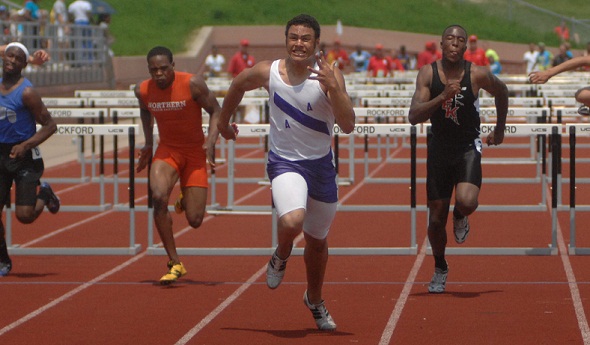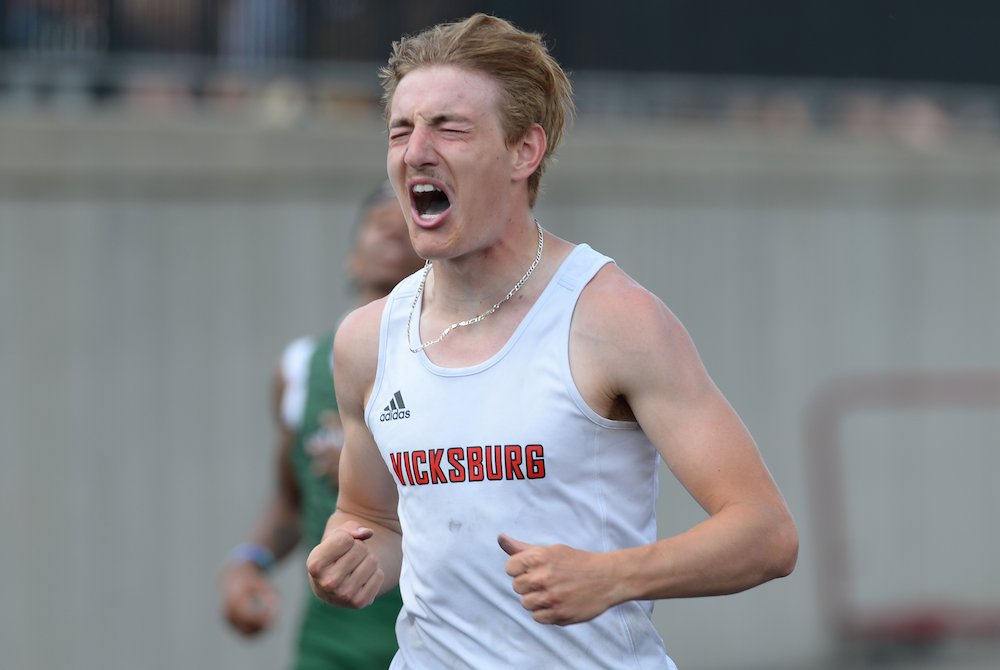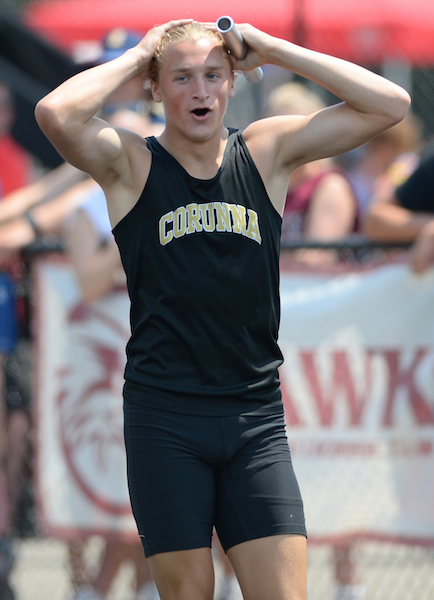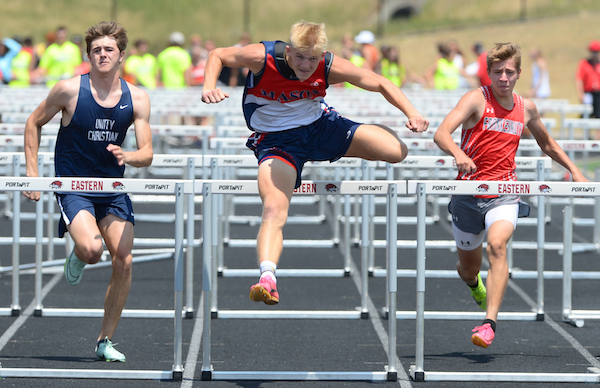
Pioneer's Johnson Focused on Finish
May 24, 2012
By Geoff Kimmerly
Second Half editor
At 6-foot-1 and a solid 205 pounds, Drake Johnson looks every bit the college running back he’ll become this fall at the University of Michigan.
And amid chasing the MHSAA record for single-season rushing yards this fall, he became a recognizable face as well.
But not long ago, Johnson was known primarily for the elite times he ran during track season. And that allowed the Ann Arbor Pioneer hurdler to have a little extra fun.
A self-admitted jokester, Johnson would get a chuckle before races while watching opponents keep a lookout for him, not realizing he was standing next to them.
“Let’s see who they think I am before the race,” Johnson would say to himself. “And once they figured out who I am, they’d be like, ‘No way! This can’t be Drake.’
“I’d just win the race.”
Now there are few in MHSAA track and field who don't recognize him – or know of the legacy he's about the leave.
Johnson is a two-time MHSAA Division 1 champion in the 110-meter hurdles, and won both that race (14.25) and the 300 hurdles (38.63) at Friday's Division 1 Regional at Saline. He owns the Pioneers’ record in the 110 hurdles of 13.7 seconds, and also will run as part of the 1,600 relay at next weekend’s Division I Final at East Kentwood High.
A Second Half High 5 recipient this week, Johnson has two goals for his final high school meet: Break the all-Finals record in the 110 of 13.6 seconds set by Detroit Central’s Thomas Wilcher in 1982, and win the 300 intermediate hurdles – a race he qualified for last season, but did not advance in past the preliminaries.
Johnson won both hurdles races at last weekend's Regional by more than a second – margins that also have become the norm. After finishing third in the 110 hurdles as a freshman at the 2009 Division 1 Final, Johnson won that race in 2010 by 34 hundredths of a second and last season by 44 hundredths.
His 13.9 Finals qualifying time this spring is the second-fastest among all four divisions. And his best time in high school competition – 13.7 – is faster than them all.
“He’s always had high aspirations to do really well,” said Pioneer coach Don Sleeman, who is finishing his 39th season coaching the Pioneers' boys team. “He’s basically been (this) way from the get-go. I’ve had kids you could see as freshmen would be really good if they developed … but Drake was really good from freshman year on. His talent was pretty obvious.”
And it’s not restricted to hurdles. Johnson would do just fine as a sprinter – for example, he’s beaten Ann Arbor Skyline’s Nathan Hansen, who posted the fifth-fastest Division 1 qualifying time in the 100 of 10.8 seconds. Johnson uses his strength to power through races like he has a ball tucked under his arm, continuously accelerating as others begin to fade.
And the hurdles offer a canvas on which he can create what he describes as his art.
“Everyone has a top speed. It's only one variable -- are you fast, or are you not fast? With hurdles, … it’s a combination of speed and hours of working on technique,” Johnson said. “There's almost that second variable to it, that X factor. A lot of people … can work on technique for hours and hours.
"It’s deeper, but at the time, it’s so incredibly simple. Whoever gets there faster wins the race. Whatever form allows me to finish the fastest, then technically I have better form than you do.”
Johnson has seven entries in the MHSAA football record book, thanks to his incredible numbers in the fall. In 12 games, Johnson ran 344 times for 2,809 yards and 37 touchdowns, and scored 38 times total. His yardage is sixth-most for one season in MHSAA history.
A downfall of his final run through high school track has been the outside expectation that he would post super-fast times in every race – although doing so hasn't always been necessary to win. Sometimes, Johnson focused more on working on nuances, or saving up energy for other events.
But he’s looking forward to one last opportunity to let fly before moving down the road and onto the next level of competition.
“Knowing that it’s my last chance to get the record, I have a sense of urgency almost,” Johnson said. “Also, if I had an actually good start, and a full race, if I run the way I feeI could run it, I’m hoping I could possibly go 13.1 – if I were to run the perfect race.”
Click to read more about Johnson's career aspirations and favorite football runners.
PHOTO: Ann Arbor Pioneer's Drake Johnson won last season's MHSAA Division 1 110 hurdles Final by nearly half a second.

Vicksburg's Wright, Corunna Right On in Claiming LPD2 Championships
By
Steve Vedder
Special for MHSAA.com
June 3, 2023
ADA – If Michael Wright was a baseball player, he probably would've been called out on strikes a year ago.
Instead, the Vicksburg senior can celebrate after winning the 200 at Saturday's Lower Peninsula Division 2 Track & Field Finals at Forest Hills Eastern.
The road to the championship in the 200, via a time of 21.72, was anything but a straight line for Wright. An aspiring baseball player, he was cut from the Vicksburg squad as a freshman. His football career, by Wright's own admission, was "on and off." And then a year ago in his first track meet, Wright suffered a leg injury that virtually ended his season. He did return to finish fifth in the 200 at Finals while helping the 400 relay team to a 16th place.
So there is nothing to realistically explain how Wright found himself in the position Saturday at sweltering Forest Hills Eastern to win a championship. Except for returning this season to break the school record in the 200 four times in two months. Well, that and willpower and simple desire.
 "I knew I could finish high, maybe in the top five. But this is better," said Wright, who credits drinking large quantities of milk for his resurgence. "I looked to football because I didn't think I could bounce back for track. But I overcame the bumps, the obstacles."
"I knew I could finish high, maybe in the top five. But this is better," said Wright, who credits drinking large quantities of milk for his resurgence. "I looked to football because I didn't think I could bounce back for track. But I overcame the bumps, the obstacles."
While Wright was jump-starting his track career, Corunna won the team title with 41 points. Mason and Forest Hills Eastern tied for second with 35. Whitehall was fourth with 33 points, and Frankenmuth fifth with 29 points.
Corunna coach Jeff Sawyer, who had never won a Finals title in 37 years coaching at Owosso and three more at Corunna, said the championship came after little fanfare during the season. Virtually right up until the time Corunna hauled off its first-place trophy, Sawyer said it was never really on his team's mind. The title came after the team managed only a runner-up finish at the Regional.
"We kind of low-keyed it," he said. "We knew scoring 40 points was possible. We lost to Frankenmuth by one point at the Regional. … We were a little disappointed we didn't win, but we had some good times today. We knew it was possible.
"Every day we just come and do what we do. We talk about getting better every day with PRs (personal records). And we're still getting better because we have some tough guys. Just competitive, tough kids. But we were the underdogs."
Corunna had only two firsts on Saturday, in the 400 relay (42.63) and Wyatt Bower in the long jump (22-8½).
Among the individual highlights was Frankenmuth senior Dalton DeBeau, who successfully defended his Finals title in the discus (171-6). He was fifth in that event as a sophomore and after winning a year ago, was considered a good bet to repeat.
"I kind of expected it," said DeBeau, who will compete at Michigan State next spring. "There wasn't a lot of pressure. I knew what had to be done. I threw 160 feet on my first throw to get in the finals, and that helped right away. I knew I could go all out."
 Berrien Springs' Jake Machiniak won the 100 (10.54) while the team also captured the 800 relay (1:28.18). Machiniak said his season hasn't been without its share of difficulties. There was a time when he couldn't seem to come out of the starting blocks smoothly. But beginning with the conference meet where he ran school record 10:73, Machiniak felt himself back on course.
Berrien Springs' Jake Machiniak won the 100 (10.54) while the team also captured the 800 relay (1:28.18). Machiniak said his season hasn't been without its share of difficulties. There was a time when he couldn't seem to come out of the starting blocks smoothly. But beginning with the conference meet where he ran school record 10:73, Machiniak felt himself back on course.
"There were ups and downs. I struggled in the middle of the season," he said. "But my teammates helped me through some difficulties. I came here to finish the job; I knew I could do something here."
Mason's Tyler Baker won the 100 hurdles (14.63) to complete a long journey that included finishing just ninth in last year's prelims. The success was as simple as putting in loads of offseason work.
"I practiced and did stuff about every day," he said. "I might not be the fastest, but I make up for that in form. It's a fine-tuning thing. Everyone wants to be faster."
Mason also got a championship from A.J. Mantel, who captured the 300 hurdles (38.90).
Among other highlights was Forest Hills Eastern senior Aiden Sullivan successfully defending a 2022 title on his own home turf. He won Saturday's 800 (1:53.92).
Adrian won the 3,200 relay (7:39.77), while Grand Rapids Christian took the 1,600 (3:24.49).
Alma had two individual winners in Michael Howey in the shot (55-08) and Jacob Dunlap in the high jump (6-7).
The other champs were Kyle Eberhard of Linden in the 1,600 (4:14.79), Whitehall's Trannon Ayler in the 400 (48.83), Freeland's T.J. Hansen in the 3,200 (9:11.56) and Sam Vesperman of Grosse Ile in the pole vault (15.01). Chelsea senior Jacob Nelson competed in the adaptive 100 (27.28), 200 (57.71) and shot put (6-6).
PHOTOS (Top) Vicksburg's Michael Wright celebrates after winning the 200 on Saturday. (Middle) Corunna's Tarick Bower enjoys a moment after anchoring the winning 400 relay. (Below) Mason's Tyler Baker, center, works to stay ahead in the 110 hurdles. (Photos by Dave McCauley/RunMichigan.com.)

